“The Sky’s The Limit” by Ralph Oppenheim
“LET’S GO!” Once more, The Three Mosquitoes familiar battle cry rings out over the western front and the three khaki Spads take to the air, each sporting the famous Mosquito insignia. In the cockpits sat three warriors who were known wherever men flew as the greatest and most hell raising trio of aces ever to blaze their way through overwhelming odds—always in front was Kirby, their impetuous young leader. Flanking him on either side were the mild-eyed and corpulent Shorty Carn, and lanky Travis, the eldest and wisest Mosquito.
We’re back with 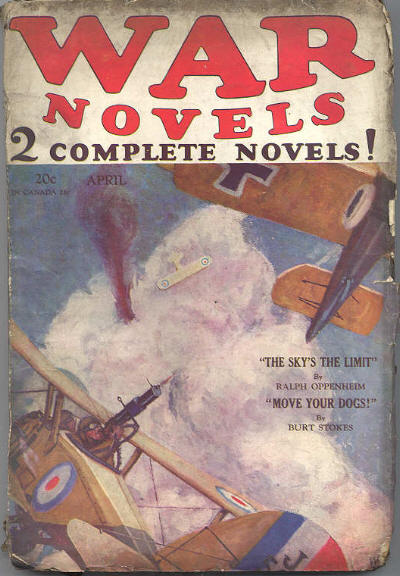 the second of three tales of Ralph Oppenheim’s Three Mosquitoes we’re featuring this March for Mosquito Month! This one is epic! The “Flying Dutchman” and his Circus have been overwhelming the Allied squadrons up and down the Western Front with their sheer numbers. Needless to say Kirby wants to take out the “Flying Dutchman”—Kellar—and put an end to his Circus. They go up again each other several times with alternating fortunes and develop a mutual admiration and respect for one another. Unfortunately, the Western Front is not big enough for both Aces.
the second of three tales of Ralph Oppenheim’s Three Mosquitoes we’re featuring this March for Mosquito Month! This one is epic! The “Flying Dutchman” and his Circus have been overwhelming the Allied squadrons up and down the Western Front with their sheer numbers. Needless to say Kirby wants to take out the “Flying Dutchman”—Kellar—and put an end to his Circus. They go up again each other several times with alternating fortunes and develop a mutual admiration and respect for one another. Unfortunately, the Western Front is not big enough for both Aces.
From the April 1928 issue of War Novels!
They were known as the “Three Mosquitoes” Kirby, Carn, and Travis—and they were famous all over the Western Front as the most daring three-plane combination that ever flew over the Boche lines and engaged the enemy planes in deadly combat. Kirby, the leader, was after Kellar, the German ace called the “Flying Dutchman”—and here is the story of what happened—one of the most thrilling and exciting flying yarns ever written! Zoom into her, gang!
And check back next Friday when the inseparable trio will be back with another exciting adventure!
Nick Royce in “Winner Take All” by Frederick C. Davis
THIS week we have 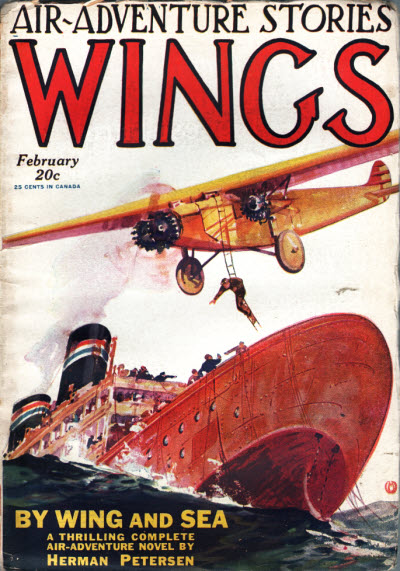 a short story by renowned pulp author Frederick C. Davis. Davis is probably best remembered for his work on Operator 5 where he penned the first 20 stories, as well as the Moon Man series for Ten Detective Aces and several other continuing series for various Popular Publications. He also wrote a number of aviation stories that appeared in Aces, Wings and Air Stories.
a short story by renowned pulp author Frederick C. Davis. Davis is probably best remembered for his work on Operator 5 where he penned the first 20 stories, as well as the Moon Man series for Ten Detective Aces and several other continuing series for various Popular Publications. He also wrote a number of aviation stories that appeared in Aces, Wings and Air Stories.
This week’s story features that crack pilot for World News Reel, the greatest gelatine newspaper that ever flashed on a silver screen—Nick Royce! Davis wrote twenty stories with Nick for Wings magazine from 1928-1931.
Tip Top, one of the biggest producers in the movie field, is looking to add a news reel to their releases and want to buy up one of the present independent movie reel producers and it’s down to Compass and World News Reel. Which ever company can out perform the other and provide the best news reels will get the gig—only problem is, someone’s on the payroll of Compass at World News Reel and causing trouble. From the April 1928 Wings, it’s Frederick C. Davis’ “Winner Take All!”
Two flyers of the newsreel wage an air-feud in the clouds, and over the flame-belching tanks of the oil fields Nick Royce, sky-eater, plays his ace-in-the-hole.
“A Fine Man—The Colonel” by Andrew A. Caffrey
THIS week we have 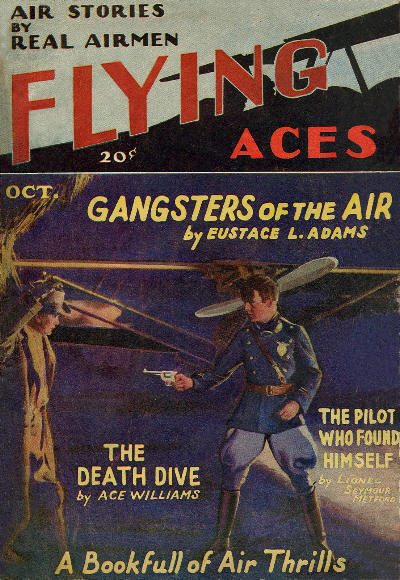 another story from one of the new flight of authors on the site this year—Andrew A. Caffrey. Caffrey, who was in the American Air Service in France during The Great War and worked for the air mail service upon his return, was a prolific author of aviation and adventure stories for both the pulps and slicks from the 1920’s through 1950. Here Caffrey tells the tale of a group of service men filling out the last months of their service stateside after the end of the war before being discharged. From the very first issue of Flying Aces October 1928 it’s Andrew A. Caffrey’s “A Fine Man—The Colonel!”
another story from one of the new flight of authors on the site this year—Andrew A. Caffrey. Caffrey, who was in the American Air Service in France during The Great War and worked for the air mail service upon his return, was a prolific author of aviation and adventure stories for both the pulps and slicks from the 1920’s through 1950. Here Caffrey tells the tale of a group of service men filling out the last months of their service stateside after the end of the war before being discharged. From the very first issue of Flying Aces October 1928 it’s Andrew A. Caffrey’s “A Fine Man—The Colonel!”
Corporal Fox didn’t think that one camp would hold HIM, Sg’t Beervat and Adjutant Lowpockets—and it didn’t. But the Colonel was a fine man.
“Hero Stuff” by Frederick C. Davis
THIS week we have  a short story by renowned pulp author Frederick C. Davis. Davis is probably best remembered for his work on Operator 5 where he penned the first 20 stories, as well as the Moon Man series for Ten Detective Aces and several other continuing series for various Popular Publications. He also wrote a number of aviation stories that appeared in Aces, Wings and Air Stories.
a short story by renowned pulp author Frederick C. Davis. Davis is probably best remembered for his work on Operator 5 where he penned the first 20 stories, as well as the Moon Man series for Ten Detective Aces and several other continuing series for various Popular Publications. He also wrote a number of aviation stories that appeared in Aces, Wings and Air Stories.
This week’s story features that crack pilot for World News Reel, the greatest gelatine newspaper that ever flashed on a silver screen—Nick Royce! Davis wrote twenty stories with Nick for Wings magazine from 1928-1931.
Hollywood comes calling at the World News Reel field when J. Harold Shaw and director arrive hoping the World News Reel pilots and cameramen can help them capture a dramatic stunt for the climax of their latest feature. Who’s j. Harold Shaw? Well, his pictures send thrills and chills up and down the prickley spines of a million girls. Right at that minute his likenesses were decorating the dresser-tops of adoring females from coast to coast. Many a dissatisfied wife thought of him as an ideal husband for herself. His face was certainly his fortune. Yes, sir, right then there wasn’t any more heroic hero in the whole flicker business than J. Harold. Needless to say, Nick took an instant dislike to Shaw—especially when he started to put the moves on his gal! From the February 1928 Wings, it’s Frederick C. Davis’ “Hero Stuff!”
Between earth and sky he hung, helpless in the useless parachute—until Nick Royce, sky-eater, jumped into space, a grim smile on his lips as he prayed for an even break!
“The Poisoned Pup Squadron” by Andrew A. Caffrey
THIS week we have 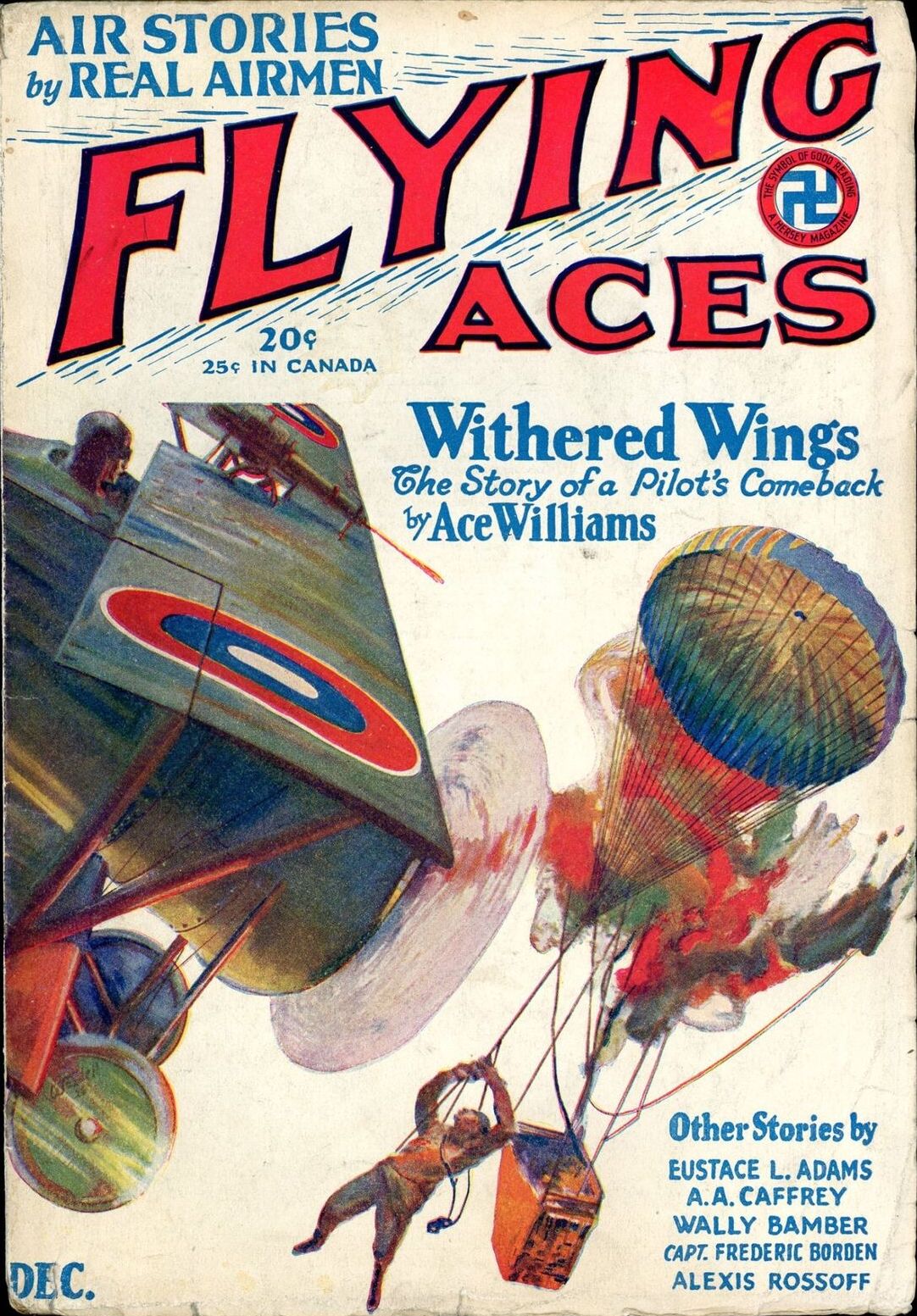 another story from one of the new flight of authors on the site this year—Andrew A. Caffrey. Caffrey, who was in the American Air Service in France during The Great War and worked for the air mail service upon his return, was a prolific author of aviation and adventure stories for both the pulps and slicks from the 1920’s through 1950. Here Caffrey tells the tale of Lieutenant Harry Pond.
another story from one of the new flight of authors on the site this year—Andrew A. Caffrey. Caffrey, who was in the American Air Service in France during The Great War and worked for the air mail service upon his return, was a prolific author of aviation and adventure stories for both the pulps and slicks from the 1920’s through 1950. Here Caffrey tells the tale of Lieutenant Harry Pond.
To hear the Fight commander tell it, “Look at the luck Pond’s having. Seven Hun planes in less than two weeks. Two in one day. And before each take-off, Harry’s down on his prayer bones in the cockpit; the while, if a mechanic comes alongside, Harry makes him think that he’s adjusting the toe straps on the rudder bar. Crafty boy, Harry; he’s just making a gang of two with God and licking the world. So I’d advise you fellows to go into partnership too.”
Thing was, Pond was messing with his rudder-bar strap. Lieutenant Pond didn’t really like killing. The killing thing, to him, was merely a part of war. He was at war, so he killed. But he killed strictly according to the book, with the true standards of sportsmanship always in mind. Even if it meant allowing an enemy pilot to return home. From the December 1928 number of Flying Aces, it’s Andrew A. Caffrey’s “The Poisoned Pup Squadron!”
When the enemy shot down Pond’s buddy in an orange-black plume of flame, doing this hellish thing against certain unwritten rules of air warfare, trouble started for fair—and then some!
“The “Ace-In-The-Hole” Gang” by F.H. Griggs, Jr.
THIS week we have another 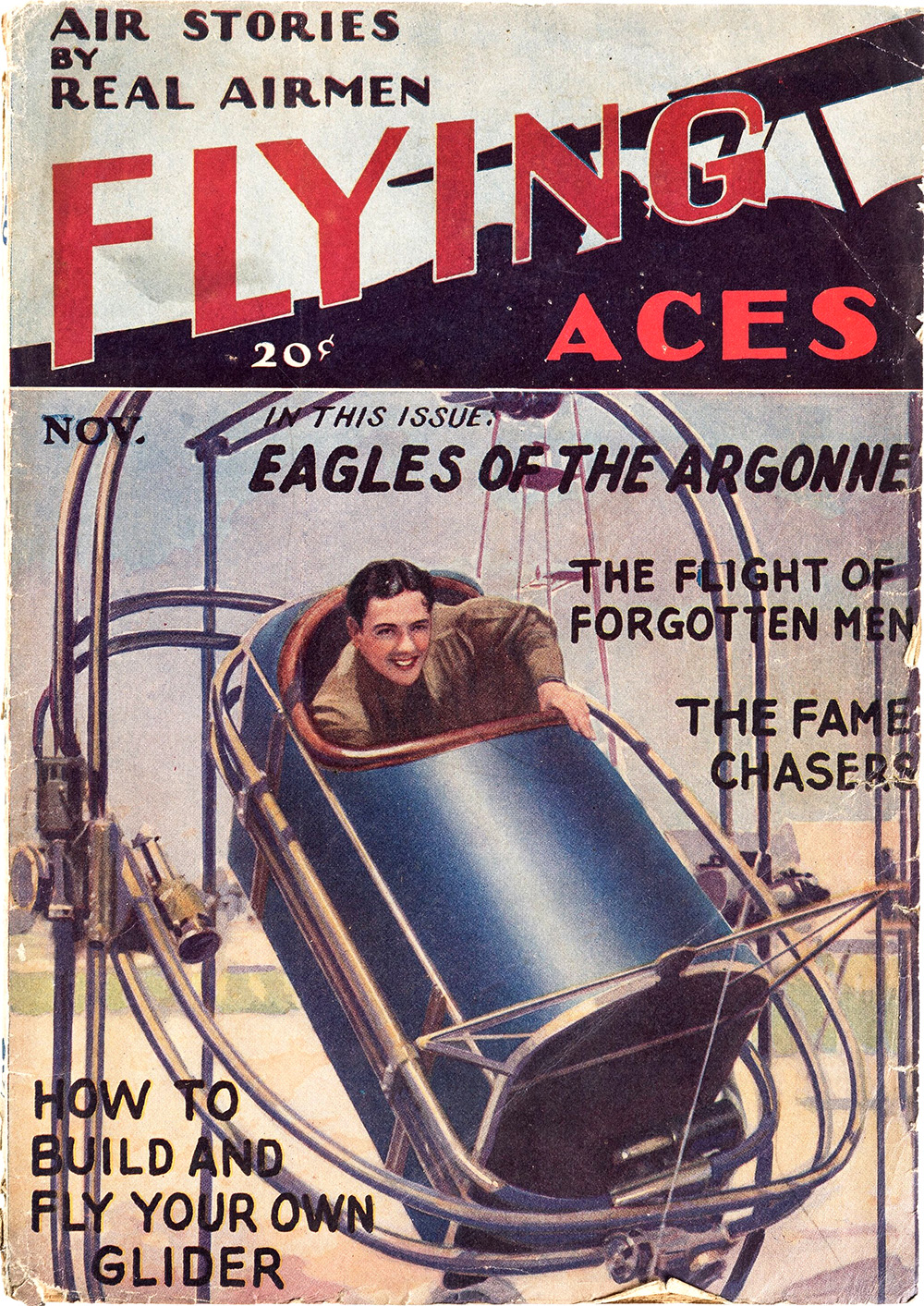 exciting air adventure from the pen of F.H. Griggs, Jr. Griggs is a rather enigmatic figure with just two stories to his name from those issues indexed by Fiction Mags.
exciting air adventure from the pen of F.H. Griggs, Jr. Griggs is a rather enigmatic figure with just two stories to his name from those issues indexed by Fiction Mags.
The “Ace-In-The-Hole” Gang is a trio of pilots who came together when they realized they had similarities in their styles of attack and in their disposition. Each of the three men had in his make-up, a strong sense of duty, a responsibility for being in the thick of things, and as time went on the love between them defied death itself. Their fame had spread all along the western front. The trio worked as an independent flight, and were able to stop and refuel at any drome as need be. They were treated as celebrities with the red carpet rolled out for them wherever they alighted.
From the pages of the November 1928 Flying Aces, F.H. Griggs, Jr. tells the tale of “The “Ace-In-The-Hole” Gang’s” final flight.
Captain Billy’s lust to kill should have been satisfied before he ran into a flight of five Fokkers, but he had a debt to pay—and the story of how he paid in full will remain with you as an unforgetable memory as long as you live!
“Two Aces—in Dutch” by Ralph Oppenheim
THROUGH the dark night sky, streaking swiftly with their Hisso engines thundering, is the greatest trio of aces on the Western Front—the famous and inseparable “Three Mosquitoes,” the mightiest flying combination that had ever blazed its way through overwhelming odds and laughed to tell of it! Flying in a V formation—at point was Captain Kirby, impetuous young leader of the great trio; on his right was little Lieutenant “Shorty” Carn, the mild-eyed, corpulent little Mosquito and lanky Lieutenant Travis, eldest and wisest of the Mosquitoes on his left!
We’re back with 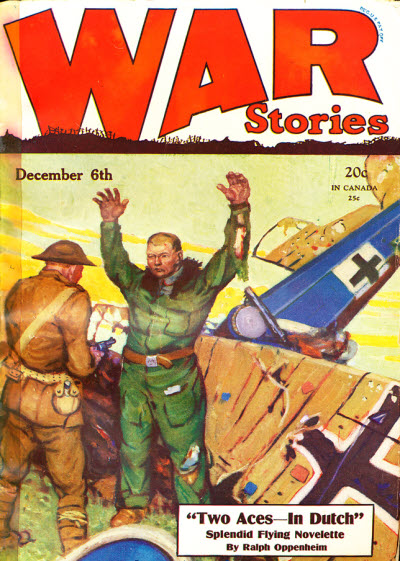 the third and final of three Ralph Oppenheim’s Three Mosquitoes stories we’re featuring this March for Mosquito Month! And this one’s a doozy! In a dogfight to the death, Kirby and the German Ace known as “The Killer” both end up going down—unfortunately, their fight had taken them off course and they have cashed in neutral Holland where both are taken into custody and are sentenced to remain in the country until the war’s end. The two bitter enemies in the air, build a fast friendship on the ground and must rely on one another if they are to escape and get back to their own squadrons! Read this incredible story in Ralph Oppenheim’s “Two Aces—in Dutch” from the December 6th, 1928 issue of War Stories!
the third and final of three Ralph Oppenheim’s Three Mosquitoes stories we’re featuring this March for Mosquito Month! And this one’s a doozy! In a dogfight to the death, Kirby and the German Ace known as “The Killer” both end up going down—unfortunately, their fight had taken them off course and they have cashed in neutral Holland where both are taken into custody and are sentenced to remain in the country until the war’s end. The two bitter enemies in the air, build a fast friendship on the ground and must rely on one another if they are to escape and get back to their own squadrons! Read this incredible story in Ralph Oppenheim’s “Two Aces—in Dutch” from the December 6th, 1928 issue of War Stories!
Kirby bad sworn to get Von Sterner, “The Killer.” Now they had met in fair combat, and the leader of the “Three Mosquitoes” was plunging to earth in a plane riddled by the Killer’s bullets. But he was not alone. The Killer’s Albatross was falling beside the crippled Spad. Then face to face on the ground, these two men, the Yank and the German, found themselves the victims of one of war’s strange tricks!
“The Invisible Ace” by Ralph Oppenheim
“LET’S GO!” Once more, The Three Mosquitoes familiar battle cry rings out over the western front and the three khaki Spads take to the air, each sporting the famous Mosquito insignia. In the cockpits sat three warriors who were known wherever men flew as the greatest and most hell raising trio of aces ever to blaze their way through overwhelming odds—always in front was Kirby, their impetuous young leader. Flanking him on either side were the mild-eyed and corpulent Shorty Carn, and lanky Travis, the eldest and wisest Mosquito.
We’re back with 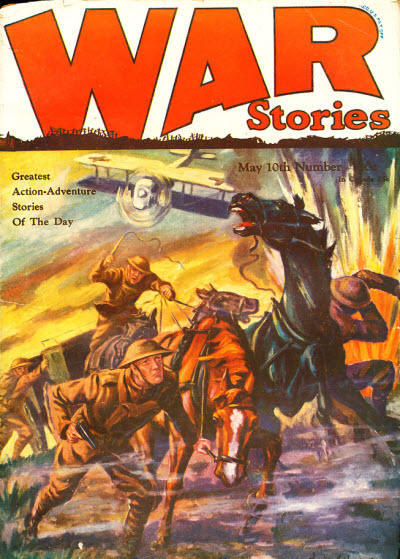 the second of three tales of Ralph Oppenheim’s Three Mosquitoes we’re featuring this March for Mosquito Month! This week, our intrepid trio hunt for the Invisible Ace!
the second of three tales of Ralph Oppenheim’s Three Mosquitoes we’re featuring this March for Mosquito Month! This week, our intrepid trio hunt for the Invisible Ace!
Seven Spads had fallen beneath the twin Spandau guns of the Invisible Ace— so called because no one had really seen this German flyer. Only a flash of wings in the sunlight, a black-cross insignia, a streaking gray shape—that was all they had seen of him. So swift would be the execution—like the trick of a master magician where the “hand is quicker than the eye”—that the other pilots of the flight could never spring into action until it was too late. They would hear the burst of machine-gun fire, and when they turned they would see the victim hurtling below them. But the Invisible Ace would already be up in the sun again, safe from prying eyes. So the Three Mosquitoes are tasked with bringing “The Invisible Ace” to light and ending his reign of terror! From the May 10th, 1928 issue of War Stories, it’s Ralph Oppenheim’s “The Invisible Ace!”
The Invisible Ace was raising hell with the squadron, and—But it’s another great flying yarn about the famous “Three Mosquitoes,” so why spill any more words about it?
And check back next Friday when the inseparable trio will be back with another exciting adventure!
“Smashed Wings” by Ralph Oppeheim
MARCH is Mosquito Month! We’re celebrating Ralph Oppenheim and his greatest creation—”The Three Mosquitoes! We’ll be featuring three early tales of the Mosquitoes over the next few Fridays as well as looking at D. Campbell’s The Three Wasps, a blatant Mosquitoes ripoff. So, let’s get things rolling, as the Mosquitoes like to say as they get into action—“Let’s Go!”
The greatest fighting war-birds on the Western Front are once again roaring into action. The three Spads flying in a V formation so precise that they seemed as one. On their trim khaki fuselages, were three identical insignias—each a huge, black-painted picture of a grim-looking mosquito. In the cockpits sat the reckless, inseparable trio known as the “Three Mosquitoes.” Captain Kirby, their impetuous young leader, always flying point. On his right, “Shorty” Carn, the mild-eyed, corpulent little Mosquito, who loved his sleep. And on Kirby’s left, completing the V, the eldest and wisest of the trio—long-faced and taciturn Travis.
Let’s get things 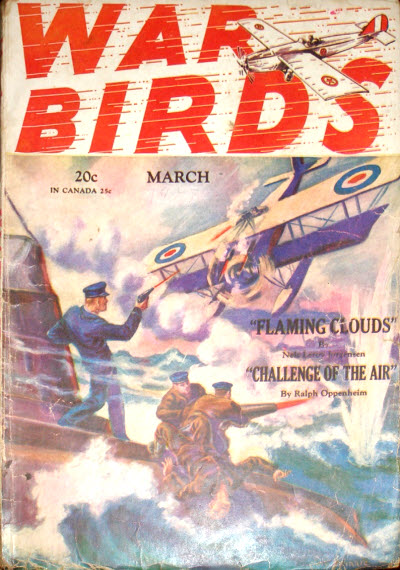 off the ground with an early Mosquitoes tale from the pages of War Stories from January 1928! The enterprise was extremely dangerous, though simple. The Three Mosquitoes had been assigned to escort a flight of bombers that were to go across the lines to Staffletz, where, besides an important railroad junction, there were some Zeppelin sheds. The railway was to be damaged as much as possible, and then the machines were to ‘‘lay their eggs” on the Zeppelin sheds. Complicating matters—Kirby was flying in an unfamiliar, old Sopwith rather than his usual Spad!
off the ground with an early Mosquitoes tale from the pages of War Stories from January 1928! The enterprise was extremely dangerous, though simple. The Three Mosquitoes had been assigned to escort a flight of bombers that were to go across the lines to Staffletz, where, besides an important railroad junction, there were some Zeppelin sheds. The railway was to be damaged as much as possible, and then the machines were to ‘‘lay their eggs” on the Zeppelin sheds. Complicating matters—Kirby was flying in an unfamiliar, old Sopwith rather than his usual Spad!
Once again the ‘’Three Mosquitoes,” with the famous Kirby leading them, go out on a daring mission. The enemy’s Zeppelin sheds had to be destroyed—But could it be done? And Kirby was flying an old plane!
And check back next Friday when the inseparable trio will be back with another exciting adventure!
“Grindin’ High” by Frederick C. Davis
THIS week we have 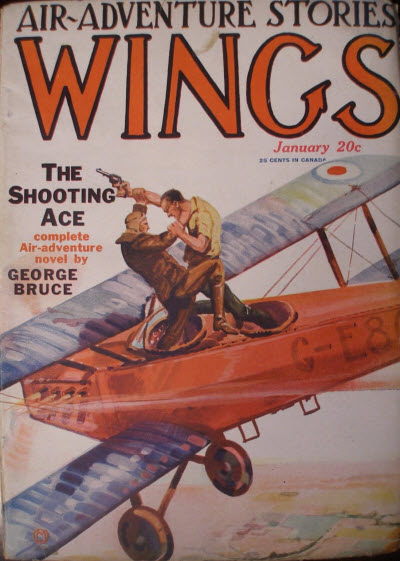 a short story by renowned pulp author Frederick C. Davis. Davis is probably best remembered for his work on Operator 5 where he penned the first 20 stories, as well as the Moon Man series for Ten Detective Aces and several other continuing series for various Popular Publications. He also wrote a number of aviation stories that appeared in Aces, Wings and Air Stories.
a short story by renowned pulp author Frederick C. Davis. Davis is probably best remembered for his work on Operator 5 where he penned the first 20 stories, as well as the Moon Man series for Ten Detective Aces and several other continuing series for various Popular Publications. He also wrote a number of aviation stories that appeared in Aces, Wings and Air Stories.
This week’s story features that crack pilot for World News Reel, the greatest gelatine newspaper that ever flashed on a silver screen—Nick Royce! Davis wrote twenty stories with Nick for Wings magazine from 1928-1931. Here, in his first story, Nick is mistaken for a world famous stunt flyer while trying to wrangle a job with the World News Newsreel service. And although he doesn’t make a good first impression he does come up with the goods in the end! From the January 1928 Wings, it’s Frederick C. Davis’ “Grinding’ High!”
A blazing steamer—a roaring furnace amid a vast expanse of desolate sea—and Nick Royce, fledgling, zoomed for the greatest scoop of all to prove himself a birdman!
“Give Her The Gun” by Eustace L. Adams
THIS week we have 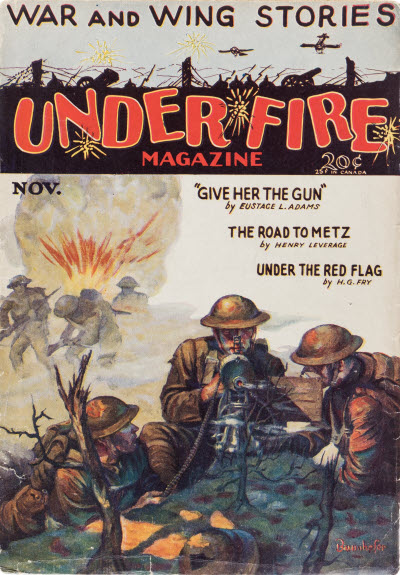 a story from the prolific pen of Eustace L. Adams. Born in 1891, Adams was an editor and author who served in the American Ambulance Service and the US Naval Service during The Great War. His aviation themed stories started appearing in 1928 in the various war and aviation pulps—Air Trails, Flying Aces, War Stories, Wings, War Birds, Sky Birds, Under Fire, Air Stories and Argosy. He is probably best remembered for the dozen or so airplane boys adventure books he wrote for the Andy Lane series.
a story from the prolific pen of Eustace L. Adams. Born in 1891, Adams was an editor and author who served in the American Ambulance Service and the US Naval Service during The Great War. His aviation themed stories started appearing in 1928 in the various war and aviation pulps—Air Trails, Flying Aces, War Stories, Wings, War Birds, Sky Birds, Under Fire, Air Stories and Argosy. He is probably best remembered for the dozen or so airplane boys adventure books he wrote for the Andy Lane series.
Ensigns Peter B. Hemmingway and Jack Lewis had been attached to the little unit of American naval aviators near Havre for a month now, and they craved action. So far as they had been concerned, the war had not been much more thrilling than their training course, back in the States. All their thrills had come secondhand. Some of the other fliers had seen action and the station had several scalps to its credit, but the two boys had been out of luck, for as faithful as they had been on their patrols they had not had a single chance to pull their release ring and drop the ugly bomb which hung suspended from the fuselage between the twin pontoons. Perhaps today their luck would turn and their chance would come—
From the November 1928 number of Under Fire, it’s Eustace L. Adams’ “Give Her The Gun!”
A hydroplane stranded—an approaching submarine—a rescuing destroyer—and dead men tell no tales.
“The Cloud Busters” by Fred Denton Moon
THIS week we have  one of the few stories from Fred Denton Moon. Moon was born in Athens, Georgia in 1905 and was a freelance writer. A former staff member of The Atlanta Journal Sunday Magazine, he was the first editor of the Journal’s wire photo service as well as former city editor of the Journal. He was member of Sigma Delta Chi and a retired member of the Georgia Department of Labor.
one of the few stories from Fred Denton Moon. Moon was born in Athens, Georgia in 1905 and was a freelance writer. A former staff member of The Atlanta Journal Sunday Magazine, he was the first editor of the Journal’s wire photo service as well as former city editor of the Journal. He was member of Sigma Delta Chi and a retired member of the Georgia Department of Labor.
Galactic Central lists just a handful of stories by Moon in their various directories:
| title |
magazine |
date |
vol |
no |
 |
| 1928 |
| The Cloud Busters |
Flying Aces |
November |
1 |
3 |
 |
| 1929 |
| The Unclaimed Necklace |
The Underworld Magazine |
February |
5 |
1 |
| The Phantom Fokker |
Sky Birds |
March |
1 |
3 |
| The Buzzard Feeder |
The Golden West Magazine |
April |
5 |
3 |
| Tortured Skies |
Flying Aces |
June |
3 |
2 |
| Lieutenant Goose-Egg |
Eagles of the Air |
November |
1 |
2 |
| The Aerial Aim |
Flying Aces |
November |
4 |
3 |
 |
| 1930 |
| The Bear Facts |
The Dragnet Magazine |
January |
4 |
4 |
|
| Front Page Stuff |
Prize Air Pilot Stories |
January |
1 |
2 |
| Gimme a Cigaret! |
Thrilling Stories |
January |
1 |
2 |
| The Rattler of No Fang |
Western Trails |
June |
6 |
1 |
 |
Moon died in 1982 at the age of 76.
His first published pulp tale is one of an overly harsh C.O., hated by his men who get no respect for making due with the Army’s worst equipment, who proves his mettle when he joins a bombing raid over enemy lines. From the pages of the November 1928 Flying Aces, it’s Fred Denton Moon’s “The Cloud Busters!”
Hades had spewed up and was spreading all over the map of France. Count von Stratton’s flying circus was the worst bunch of hornets that had ever stung to death the group of able flyers under the disliked Commandant Legarrin—but the Commandant was an old devil who knew his viewpoint so well he tried to stop the war all by himself.
“Silent Peters—Hell-cat” by Alexis Rossoff
THIS week we have another 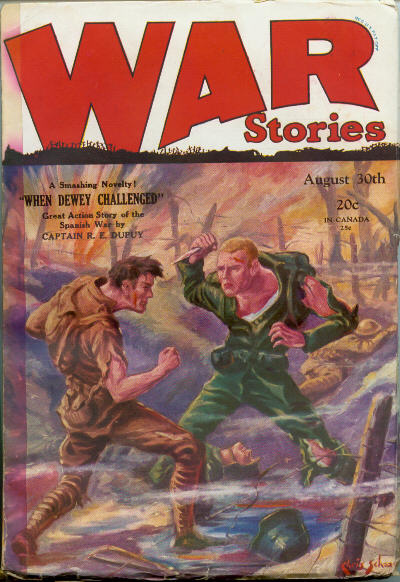 exciting adventure in those Hell-skies with Alexis Rossoff’s Hell-Cat Squadron! The adventures of the Hell-Cat Brood ran in War Birds, War Stories and Flying Aces. The Seventy-Seventh Squadron had a reputation of being short on technique and long on defying every regulation in the book. The squadron was the cause of many gray hairs on the pates of the star-spangled ones back in G.H.Q. They flew their merry way like nobody’s business, and played hell with any Jerry who tried to dispute their intention of going places. This bunch of cloud-hopping war birds were known from one end of the Western front to the other as the “Hell-cats”—and sometimes the “Unholy Dozen!”
exciting adventure in those Hell-skies with Alexis Rossoff’s Hell-Cat Squadron! The adventures of the Hell-Cat Brood ran in War Birds, War Stories and Flying Aces. The Seventy-Seventh Squadron had a reputation of being short on technique and long on defying every regulation in the book. The squadron was the cause of many gray hairs on the pates of the star-spangled ones back in G.H.Q. They flew their merry way like nobody’s business, and played hell with any Jerry who tried to dispute their intention of going places. This bunch of cloud-hopping war birds were known from one end of the Western front to the other as the “Hell-cats”—and sometimes the “Unholy Dozen!”
There was one man responsible for “Silent” Peters’ warped outlook on life. One man who turned a brilliant engineer into a man who hates the world, God and life itself. An Ace who was tall, gaunt and taciturn with the eyes of a saint—and the face of a devil with nothing but hate in his heart! And Silent Peters believed he would find this man in the death-torn Hell skies over Germany and settle the score once and for all! From the pages of the August 30th, 1928 issue of War Stories, it’s Alexis Rossoff’s “Silent Peters—Hell-cat!”
He was lean and tall and firm-jawad, this Yank of the Seventy-Seventh Squadron. That was the bunch of cloud-hopping war birds they called the “Hell-cats,†and sometimes the “Unholy Dozen.†But “Silent†Peters was a lone eagle without a buddie in the squadron. He had a reason for his war—a reason that meant more than life.
“Luck in the Blue” by James Perley Hughes
TODAY we have  a story from the pen of a prolific pulp author James Perley Hughes! Hughes was managing editor of the San Francisco Chronicle before turning his hand towards fiction and becoming a frequent contributor to various adventure pulps—but he seemed to gravitate toward the air-war spy type stories.
a story from the pen of a prolific pulp author James Perley Hughes! Hughes was managing editor of the San Francisco Chronicle before turning his hand towards fiction and becoming a frequent contributor to various adventure pulps—but he seemed to gravitate toward the air-war spy type stories.
A spy was loose on the base, but Zoom Hale had bigger problems—his childhood buddy and wing-man Charlie Spellman was in a bad way with a sudden attack of nerves. He had been through and seen enough and Zoom thought his pal was ready to end it all. So when Charlie takes his plane out early the next morning, Zoom dashes off to keep him from doing just that and try to bring him down without killing his best friend in the process!
The whirring air yarn of a man who felt he had to chase his own buddy—who had to sit on his soul to shoot down his pal. Then—a zooming finish but unexpected and thrilling!
“Buck Manley, Balloon Buster” by Lloyd Leonard Howard
THIS week we have 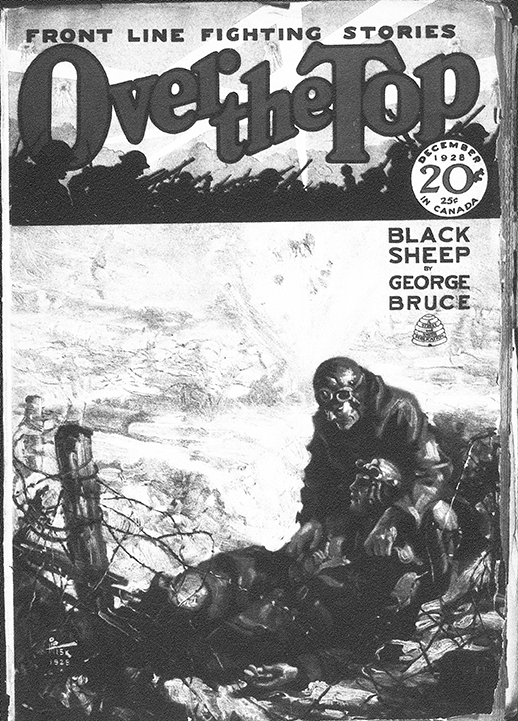 another Buck Manley story by Lloyd Leonard Howard from the pages of Street & Smith’s short lived Over The Top magazine. Over The Top was a magazine featuring war stories by the likes of Arthur Guy Empey, George Bruce, Raoul Whitfield among others. One of those others being Lloyd Leonard Howard who had stories in about a dozen of the 21 issues. Several of them featured a pilot by the name of Lieutenant Buck Manley and his pal Lieutenant “Stubby†Davis. For some reason or other, enemy craft were scarce since the St. Mihiel drive and although Boche crates were few and far between there were still Boche observation Balloons to down! From the December 1928 issue of Over The Top, it’s Lloyd Leonard Howard’s “Buck Manley, Balloon Buster!”
another Buck Manley story by Lloyd Leonard Howard from the pages of Street & Smith’s short lived Over The Top magazine. Over The Top was a magazine featuring war stories by the likes of Arthur Guy Empey, George Bruce, Raoul Whitfield among others. One of those others being Lloyd Leonard Howard who had stories in about a dozen of the 21 issues. Several of them featured a pilot by the name of Lieutenant Buck Manley and his pal Lieutenant “Stubby†Davis. For some reason or other, enemy craft were scarce since the St. Mihiel drive and although Boche crates were few and far between there were still Boche observation Balloons to down! From the December 1928 issue of Over The Top, it’s Lloyd Leonard Howard’s “Buck Manley, Balloon Buster!”
There are certain things you can’t explain to G.H.Q.—sometimes you just have to show ’em!
 the second of three tales of Ralph Oppenheim’s Three Mosquitoes we’re featuring this March for Mosquito Month! This one is epic! The “Flying Dutchman” and his Circus have been overwhelming the Allied squadrons up and down the Western Front with their sheer numbers. Needless to say Kirby wants to take out the “Flying Dutchman”—Kellar—and put an end to his Circus. They go up again each other several times with alternating fortunes and develop a mutual admiration and respect for one another. Unfortunately, the Western Front is not big enough for both Aces.
the second of three tales of Ralph Oppenheim’s Three Mosquitoes we’re featuring this March for Mosquito Month! This one is epic! The “Flying Dutchman” and his Circus have been overwhelming the Allied squadrons up and down the Western Front with their sheer numbers. Needless to say Kirby wants to take out the “Flying Dutchman”—Kellar—and put an end to his Circus. They go up again each other several times with alternating fortunes and develop a mutual admiration and respect for one another. Unfortunately, the Western Front is not big enough for both Aces.




 a short story by renowned pulp author Frederick C. Davis. Davis is probably best remembered for his work on Operator 5 where he penned the first 20 stories, as well as the Moon Man series for Ten Detective Aces and several other continuing series for various Popular Publications. He also wrote a number of aviation stories that appeared in Aces, Wings and Air Stories.
a short story by renowned pulp author Frederick C. Davis. Davis is probably best remembered for his work on Operator 5 where he penned the first 20 stories, as well as the Moon Man series for Ten Detective Aces and several other continuing series for various Popular Publications. He also wrote a number of aviation stories that appeared in Aces, Wings and Air Stories.  another story from one of the new flight of authors on the site this year—Andrew A. Caffrey. Caffrey, who was in the American Air Service in France during The Great War and worked for the air mail service upon his return, was a prolific author of aviation and adventure stories for both the pulps and slicks from the 1920’s through 1950. Here Caffrey tells the tale of a group of service men filling out the last months of their service stateside after the end of the war before being discharged. From the very first issue of Flying Aces October 1928 it’s Andrew A. Caffrey’s “A Fine Man—The Colonel!”
another story from one of the new flight of authors on the site this year—Andrew A. Caffrey. Caffrey, who was in the American Air Service in France during The Great War and worked for the air mail service upon his return, was a prolific author of aviation and adventure stories for both the pulps and slicks from the 1920’s through 1950. Here Caffrey tells the tale of a group of service men filling out the last months of their service stateside after the end of the war before being discharged. From the very first issue of Flying Aces October 1928 it’s Andrew A. Caffrey’s “A Fine Man—The Colonel!” another story from one of the new flight of authors on the site this year—Andrew A. Caffrey. Caffrey, who was in the American Air Service in France during The Great War and worked for the air mail service upon his return, was a prolific author of aviation and adventure stories for both the pulps and slicks from the 1920’s through 1950. Here Caffrey tells the tale of Lieutenant Harry Pond.
another story from one of the new flight of authors on the site this year—Andrew A. Caffrey. Caffrey, who was in the American Air Service in France during The Great War and worked for the air mail service upon his return, was a prolific author of aviation and adventure stories for both the pulps and slicks from the 1920’s through 1950. Here Caffrey tells the tale of Lieutenant Harry Pond.  exciting air adventure from the pen of F.H. Griggs, Jr. Griggs is a rather enigmatic figure with just two stories to his name from those issues indexed by Fiction Mags.
exciting air adventure from the pen of F.H. Griggs, Jr. Griggs is a rather enigmatic figure with just two stories to his name from those issues indexed by Fiction Mags.  the third and final of three Ralph Oppenheim’s Three Mosquitoes stories we’re featuring this March for Mosquito Month! And this one’s a doozy! In a dogfight to the death, Kirby and the German Ace known as “The Killer” both end up going down—unfortunately, their fight had taken them off course and they have cashed in neutral Holland where both are taken into custody and are sentenced to remain in the country until the war’s end. The two bitter enemies in the air, build a fast friendship on the ground and must rely on one another if they are to escape and get back to their own squadrons! Read this incredible story in Ralph Oppenheim’s “Two Aces—in Dutch” from the December 6th, 1928 issue of War Stories!
the third and final of three Ralph Oppenheim’s Three Mosquitoes stories we’re featuring this March for Mosquito Month! And this one’s a doozy! In a dogfight to the death, Kirby and the German Ace known as “The Killer” both end up going down—unfortunately, their fight had taken them off course and they have cashed in neutral Holland where both are taken into custody and are sentenced to remain in the country until the war’s end. The two bitter enemies in the air, build a fast friendship on the ground and must rely on one another if they are to escape and get back to their own squadrons! Read this incredible story in Ralph Oppenheim’s “Two Aces—in Dutch” from the December 6th, 1928 issue of War Stories! the second of three tales of Ralph Oppenheim’s Three Mosquitoes we’re featuring this March for Mosquito Month! This week, our intrepid trio hunt for the Invisible Ace!
the second of three tales of Ralph Oppenheim’s Three Mosquitoes we’re featuring this March for Mosquito Month! This week, our intrepid trio hunt for the Invisible Ace! off the ground with an early Mosquitoes tale from the pages of War Stories from January 1928! The enterprise was extremely dangerous, though simple. The Three Mosquitoes had been assigned to escort a flight of bombers that were to go across the lines to Staffletz, where, besides an important railroad junction, there were some Zeppelin sheds. The railway was to be damaged as much as possible, and then the machines were to ‘‘lay their eggs” on the Zeppelin sheds. Complicating matters—Kirby was flying in an unfamiliar, old Sopwith rather than his usual Spad!
off the ground with an early Mosquitoes tale from the pages of War Stories from January 1928! The enterprise was extremely dangerous, though simple. The Three Mosquitoes had been assigned to escort a flight of bombers that were to go across the lines to Staffletz, where, besides an important railroad junction, there were some Zeppelin sheds. The railway was to be damaged as much as possible, and then the machines were to ‘‘lay their eggs” on the Zeppelin sheds. Complicating matters—Kirby was flying in an unfamiliar, old Sopwith rather than his usual Spad! a short story by renowned pulp author Frederick C. Davis. Davis is probably best remembered for his work on Operator 5 where he penned the first 20 stories, as well as the Moon Man series for Ten Detective Aces and several other continuing series for various Popular Publications. He also wrote a number of aviation stories that appeared in Aces, Wings and Air Stories.
a short story by renowned pulp author Frederick C. Davis. Davis is probably best remembered for his work on Operator 5 where he penned the first 20 stories, as well as the Moon Man series for Ten Detective Aces and several other continuing series for various Popular Publications. He also wrote a number of aviation stories that appeared in Aces, Wings and Air Stories.  a story from the prolific pen of Eustace L. Adams. Born in 1891, Adams was an editor and author who served in the American Ambulance Service and the US Naval Service during The Great War. His aviation themed stories started appearing in 1928 in the various war and aviation pulps—Air Trails, Flying Aces, War Stories, Wings, War Birds, Sky Birds, Under Fire, Air Stories and Argosy. He is probably best remembered for the dozen or so airplane boys adventure books he wrote for the Andy Lane series.
a story from the prolific pen of Eustace L. Adams. Born in 1891, Adams was an editor and author who served in the American Ambulance Service and the US Naval Service during The Great War. His aviation themed stories started appearing in 1928 in the various war and aviation pulps—Air Trails, Flying Aces, War Stories, Wings, War Birds, Sky Birds, Under Fire, Air Stories and Argosy. He is probably best remembered for the dozen or so airplane boys adventure books he wrote for the Andy Lane series. one of the few stories from Fred Denton Moon. Moon was born in Athens, Georgia in 1905 and was a freelance writer. A former staff member of The Atlanta Journal Sunday Magazine, he was the first editor of the Journal’s wire photo service as well as former city editor of the Journal. He was member of Sigma Delta Chi and a retired member of the Georgia Department of Labor.
one of the few stories from Fred Denton Moon. Moon was born in Athens, Georgia in 1905 and was a freelance writer. A former staff member of The Atlanta Journal Sunday Magazine, he was the first editor of the Journal’s wire photo service as well as former city editor of the Journal. He was member of Sigma Delta Chi and a retired member of the Georgia Department of Labor.  exciting adventure in those Hell-skies with Alexis Rossoff’s Hell-Cat Squadron! The adventures of the Hell-Cat Brood ran in War Birds, War Stories and Flying Aces. The Seventy-Seventh Squadron had a reputation of being short on technique and long on defying every regulation in the book. The squadron was the cause of many gray hairs on the pates of the star-spangled ones back in G.H.Q. They flew their merry way like nobody’s business, and played hell with any Jerry who tried to dispute their intention of going places. This bunch of cloud-hopping war birds were known from one end of the Western front to the other as the “Hell-cats”—and sometimes the “Unholy Dozen!”
exciting adventure in those Hell-skies with Alexis Rossoff’s Hell-Cat Squadron! The adventures of the Hell-Cat Brood ran in War Birds, War Stories and Flying Aces. The Seventy-Seventh Squadron had a reputation of being short on technique and long on defying every regulation in the book. The squadron was the cause of many gray hairs on the pates of the star-spangled ones back in G.H.Q. They flew their merry way like nobody’s business, and played hell with any Jerry who tried to dispute their intention of going places. This bunch of cloud-hopping war birds were known from one end of the Western front to the other as the “Hell-cats”—and sometimes the “Unholy Dozen!” a story from the pen of a prolific pulp author James Perley Hughes! Hughes was managing editor of the San Francisco Chronicle before turning his hand towards fiction and becoming a frequent contributor to various adventure pulps—but he seemed to gravitate toward the air-war spy type stories.
a story from the pen of a prolific pulp author James Perley Hughes! Hughes was managing editor of the San Francisco Chronicle before turning his hand towards fiction and becoming a frequent contributor to various adventure pulps—but he seemed to gravitate toward the air-war spy type stories.  another Buck Manley story by Lloyd Leonard Howard from the pages of Street & Smith’s short lived Over The Top magazine. Over The Top was a magazine featuring war stories by the likes of Arthur Guy Empey, George Bruce, Raoul Whitfield among others. One of those others being Lloyd Leonard Howard who had stories in about a dozen of the 21 issues. Several of them featured a pilot by the name of Lieutenant Buck Manley and his pal Lieutenant “Stubby†Davis. For some reason or other, enemy craft were scarce since the St. Mihiel drive and although Boche crates were few and far between there were still Boche observation Balloons to down! From the December 1928 issue of Over The Top, it’s Lloyd Leonard Howard’s “Buck Manley, Balloon Buster!”
another Buck Manley story by Lloyd Leonard Howard from the pages of Street & Smith’s short lived Over The Top magazine. Over The Top was a magazine featuring war stories by the likes of Arthur Guy Empey, George Bruce, Raoul Whitfield among others. One of those others being Lloyd Leonard Howard who had stories in about a dozen of the 21 issues. Several of them featured a pilot by the name of Lieutenant Buck Manley and his pal Lieutenant “Stubby†Davis. For some reason or other, enemy craft were scarce since the St. Mihiel drive and although Boche crates were few and far between there were still Boche observation Balloons to down! From the December 1928 issue of Over The Top, it’s Lloyd Leonard Howard’s “Buck Manley, Balloon Buster!”